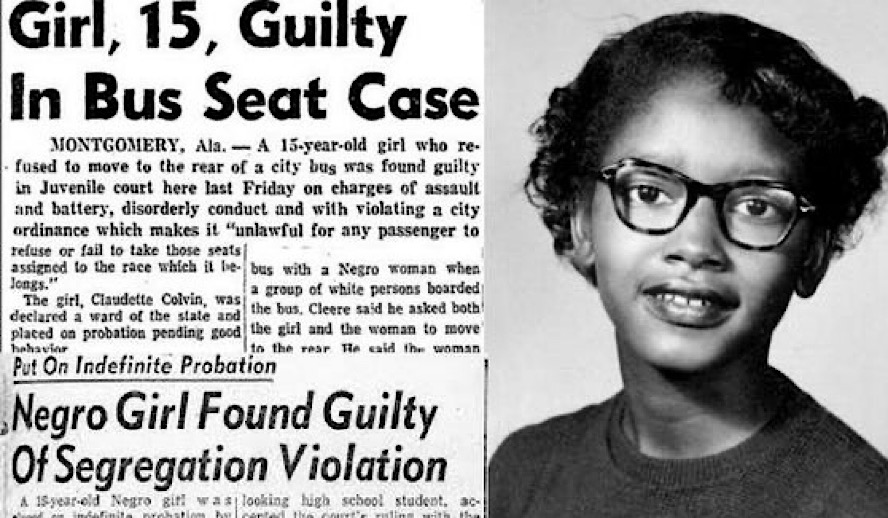BHM Spotlight: Claudette Colvin- the Girl who Came Before Rosa Parks
February 24, 2021
Unlike the broadly known story of Rosa Parks, the famous black rights activist who refused to give up her seat on a segregated bus, few know the story of a young girl named Claudette Colvin who was actually the first African American to refuse to give up their seat on public transportation. Many know that the bus boycotts stemming from Rosa Parks v Montgomery, Alabama began in 1955, but it’s a common misconception that she was the only black woman to voice her growing disdain for bus segregation laws, as plenty of others also voiced their opinions but were silenced by state fines. However, it was Claudette Colvin who would be the first to take one step beyond being vocal about segregation laws by actually challenging the legal system itself.
On March 2 of 1955, 15-year-old Claudette was on her way home from school and hopped on the bus to ride home with her friends like normal. Segregation was a normal thing for the 50s, churches, waiting rooms, schools, stairways, water fountains, stores, and most other public places were littered with signs enamored in bold lettering detailing racist rhetoric with the frequent “WHITES ONLY” “COLORED ONLY” labels. The bus had filled up quickly, and soon the driver was asking Colvin and her two friends to stand in the back to make room for three new white passengers who had gotten on. Colvin’s friends obliged and began moving, however, seeing that the person about to take her place was not disabled or elderly in any way, just a normal white woman, Claudette refused. Rather than move or try to reason, Colvin argued that she had paid her fare to ride the bus and that it was her constitutional right to remain in her selected seat. She expressed that she would not have moved off that bus voluntarily, and in return, the bus driver ordered two officers to physically remove Colvin from her seat. Many onlookers watched as her school books flew from her lap and landed on the floor of the bus with a hard thud as she was forcefully gripped by the attending officers who proceeded to pull her from the bus and bring her to the county jail. Colvin mentioned she was learning about black history at school that week which fueled her fire to challenge segregation laws on the day of her protest.
Colvin’s protest came nine months before Rosa Parks challenged segregated bus laws herself, yet, it seems her story has been almost completely erased from history, but why? How did a fifteen-year-old black girl with a strong will and fierce initiative to challenge racists laws get overshadowed by someone who preceded her in the same city, on the same bus system, with similar consequences? For starters, Colvin was only fifteen at the time, and many figured that because Parks was an adult, she would make a better figurehead for the bus boycott movement, especially because Colvin fell pregnant whilst underage soon after. Colorism also played a huge role as many also felt that because Parks had a lighter skin tone than Colvin, that she would be received better by their target audience. While there is no denying that the activist work of Rosa Parks was groundbreaking and such an integral part of the Civil Rights Movement, the same attention should be given to Claudette who took her efforts one step further by challenging the law in the courtroom. While Rosa Parks spearheaded the bus boycotts, Colvin was one of the four female plaintiffs who took the issue to the courts in Browder vs Gayle.
Colvin only sat in jail for three hours before her mother and pastor came to bail her out, but continued to challenge the system afterward. “Well Claudette, you finally did it” was the first thing Colvin’s mother said whilst picking her up from the jail, and that was certainly true because her efforts worked as perhaps a lesser-known catalyst to help end segregation laws. Colvin’s mother knew her daughter had a growing disdain for the racist laws in the country, especially after they had to take a trip to a “whites-only” store to purchase a pair of shoes. Due to Claudette’s skin color, she was not permitted to try anything on, so her mother had to trace her foot size on a brown paper bag to use as a reference while shopping. These experiences would ultimately fuel Claudette’s fire for reform that, despite having astounding impacts, came at a cost. Colvin mentioned that after her bus protest she was shunned by members of her community, targeted by whites from around the city, and even recalled her neighbors and father having to stay up into the night cradling shotguns out of fear that the KKK would try to harm her family.
For only being fifteen, Claudette’s sheer bravery and willingness to defy the law to seek true justice for her community certainly deserves praise. Unfortunately, circumstances involving her age and skin color hid her from the spotlight, but that certainly does not diminish the impact of her work. Together, Colvin, Rosa Parks, and hundreds of other ambitious black citizens fought diligently to end segregation laws (that should have never been implemented in the first place), and therefore all of them deserve to be uplifted rather than overshadowed by one another. Had it not been for the incredible Claudette true change would have never transpired, and as a society, I believe the one thing we can do to pay homage to her work is to not only educate ourselves on her impact but also continuously fight systems of injustice in this country that still uphold racism to make a change for the greater good in the same way she intended.



